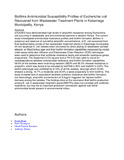Biofilms and Antimicrobial Susceptibility Profiles of Escherichia coli Recovered from Wastewater Treatment Plants in Kakamega Municipality, Kenya
Date
2121-03Author
Boge, Evans
Nyongesa, Peter
Kirsteen, Okoth Patrick
Sifuna, Anthony
Metadata
Show full item recordAbstract
STUDIES have demonstrated high levels of ampicillin resistance among Escherichia coli occurring in wastewater and environmental systems in western Kenya. The current study investigated antimicrobial resistance profiles and biofilm formation abilities in presence and absence of sub-lethal ampicillin concentrations, of E. coli recovered from final sedimentation ponds of two wastewater treatment plants in Kakamega municipality. 34 non-duplicate E. coli isolates were recovered by direct plating of wastewater sample aliquots on MacConkey agar and their biofilm formation capabilities measured by crystal violet assay while disc diffusion and Polymerase Chain Reaction (PCR) techniques were used to determine their antibiotic resistance levels and ampicillin resistance genes respectively. The Spearman’s Chi-square test at P≤ 0.05 was used to check for interdependence between antimicrobial resistance and biofilm formation capabilities. 58.8% of the isolates were multi-drug resistant (MDR) and 85.3% showed resistance to ampicillin, which was found to be encoded by blaTEM in 65% and blaSHV in 8.8%. The biofilm phenotype was exhibited by 61.8% of all the isolates, amongst which 23.6% showed a strong, 14.7% a moderate and 23.6% a weak propensity to form biofilms. This study revealed lack of association between antibiotic resistance and biofilm formation, but interestingly, ampicillin concentration of 8.0μg/ml triggered the highest biofilm biomass among the isolates. The findings drive at the conclusion that biofilm production among E. coli in wastewater treatment plants(WWTPs) does not correlate with antibiotic resistance, but may be an important protection mechanism against sub-lethal antimicrobial levels present in environmental milieu.
URI
https://doi.org/10.21608/ejm.2021.41683.1171https://www.researchgate.net/publication/349978988_Biofilms_and_Antimicrobial_Susceptibility_Profiles_of_Escherichia_coli_Recovered_from_Wastewater_Treatment_Plants_in_Kakamega_Municipality_Kenya
http://r-library.mmust.ac.ke/123456789/1577
Collections
- Gold Collection [989]

